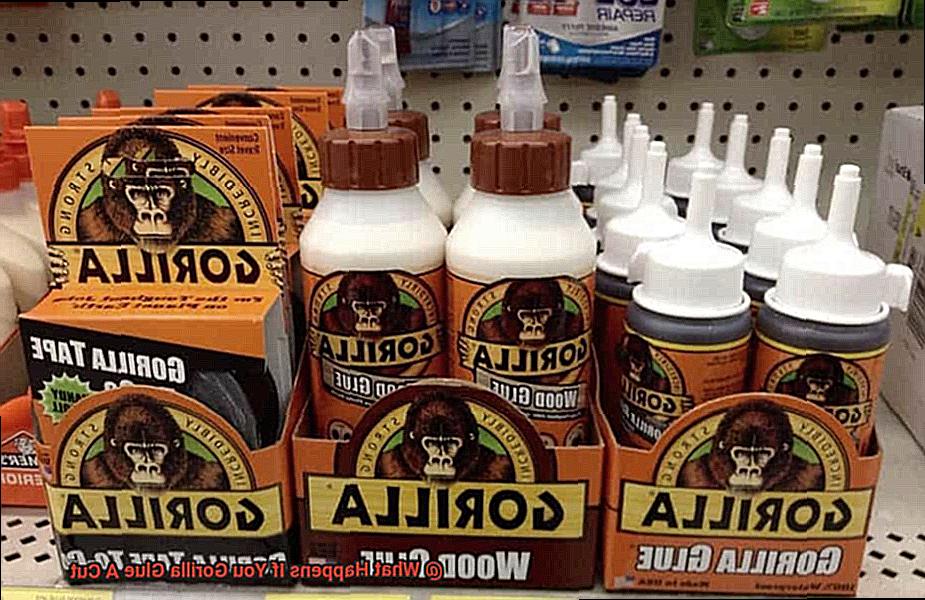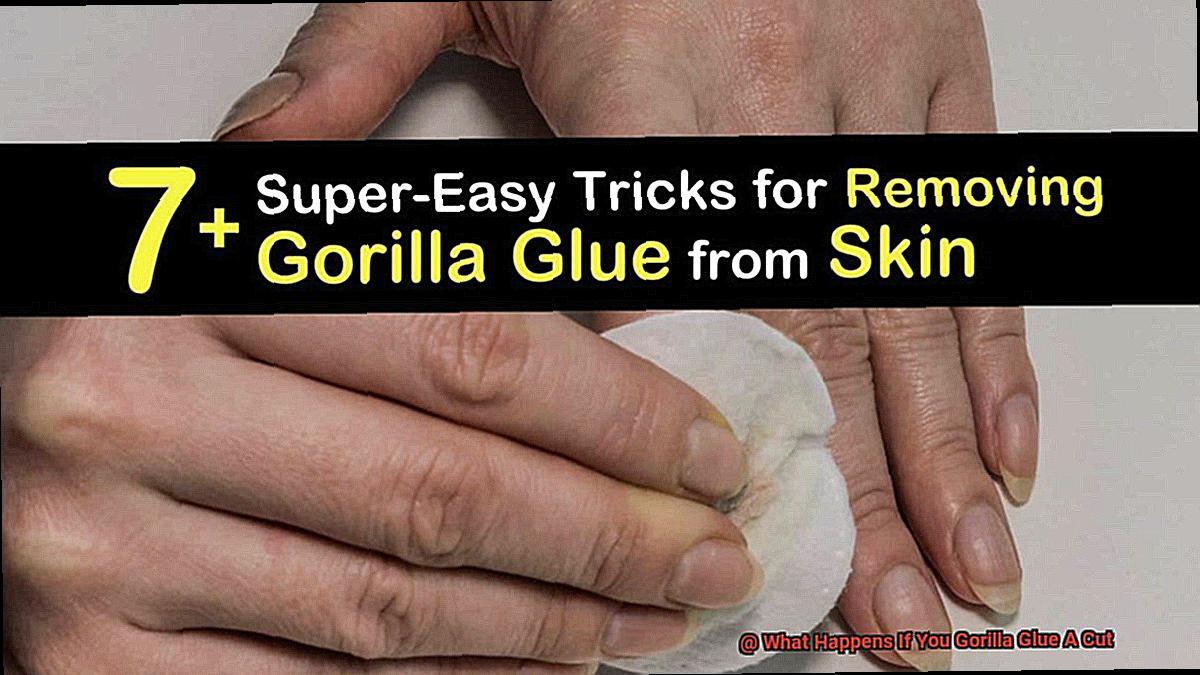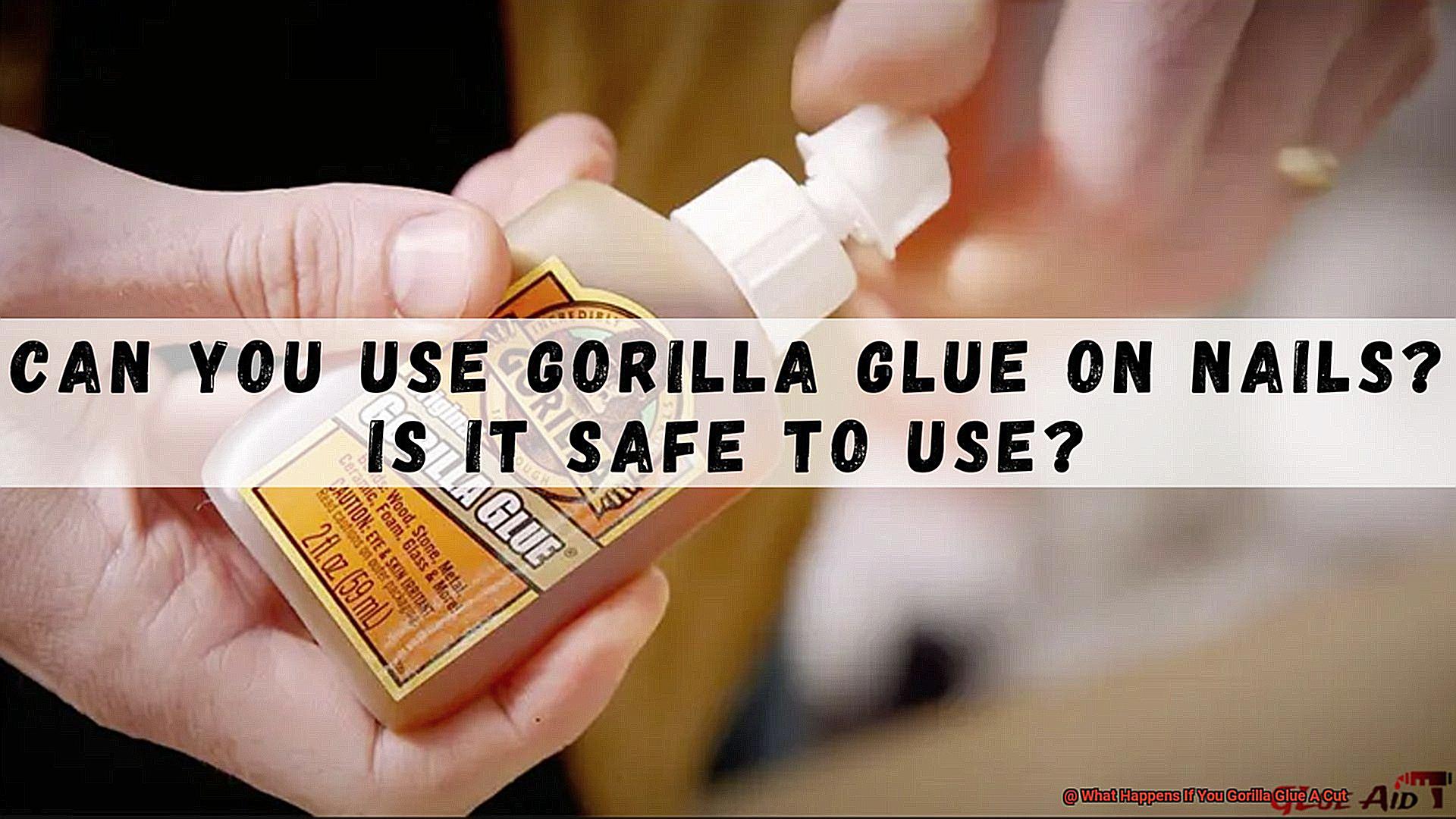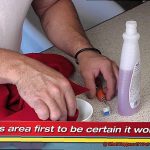We’ve all been there – one minute you’re chopping veggies or tackling a home project, and the next, you’ve got an unexpected cut. In those panicked moments, reaching for the nearest adhesive seems like the logical thing to do.
And hey, why not use Gorilla Glue? It’s famous for its Herculean strength and unyielding durability, right? But before you grab that glue bottle and become your own makeshift doctor, let’s take a minute to explore what might actually happen.
In this blog post, we’re diving headfirst into the world of wound care, chemicals, and the amazing healing powers of our bodies. We’ll uncover the potential consequences of slapping Gorilla Glue on your precious cuts.
While it may be tempting to seal up that wound in an instant and avoid a trip to the ER, trust us when we say this approach deserves some serious thought.
So, buckle up as we uncover the risks involved with using Gorilla Glue on cuts and reveal some safer alternatives to tackle your gory troubles.
Get ready for a sticky ride through the fascinating side of wound care that you never even knew existed.
Why You Should Not Use Gorilla Glue on Cuts
Contents
- 1 Why You Should Not Use Gorilla Glue on Cuts
- 2 The Risks of Applying Gorilla Glue to a Cut
- 3 How Gorilla Glue Can Affect the Healing Process
- 4 Allergic Reactions to Gorilla Glue
- 5 What to Do If You Accidentally Use Gorilla Glue on a Cut
- 6 Preventing Accidents with Gorilla Glue
- 7 Proper Wound Care Techniques for Cuts and Wounds
- 8 Conclusion
When it comes to tackling DIY projects and repairs, many people turn to the robust bonding capabilities of Gorilla Glue. However, it is vital to understand that this adhesive is not suitable for treating cuts or wounds.
In this article, we will delve into the potential risks associated with using Gorilla Glue on cuts, emphasizing the significance of proper wound care and seeking medical attention when necessary.
Irritation and Inflammation:
The chemical composition of Gorilla Glue can be harsh on delicate skin and tissues. Applying it to a cut can lead to irritation, inflammation, and even trigger allergic reactions. Prioritizing the well-being of your skin means steering clear of this adhesive when it comes to cuts.
Risk of Infection:
Unlike sterilized medical adhesives or sutures, Gorilla Glue lacks sterility. Consequently, using it on a wound heightens the risk of introducing harmful bacteria and other microorganisms, paving the way for infections. Properly cleaning the wound and employing antiseptic solutions are indispensable in preventing such complications.
Hindering Proper Healing:
Gorilla Glue forms a formidable bond upon exposure to moisture. While this quality makes it ideal for various applications, it becomes problematic when used on cuts. The adhesive has the potential to bind the cut’s edges together, hampering the natural healing process and potentially causing delayed healing, scarring, or even abscess formation.
Lack of Medical Benefits:

It is important to note that Gorilla Glue is neither formulated nor tested for medical purposes. It lacks antibacterial properties and does not promote wound healing. Relying on specialized medical products designed for wound closure and healing is indispensable in ensuring optimal results.
The Risks of Applying Gorilla Glue to a Cut
We’ve all been in that desperate moment when we reach for any quick solution to fix a problem. But when it comes to cuts and wounds, using Gorilla Glue is definitely not the answer.
This powerful adhesive may have its uses, but applying it to a cut can have serious consequences.
Let’s explore the risks of using Gorilla Glue on wounds and understand why proper wound care is essential.
Irritation and Allergic Reactions:
Gorilla Glue contains chemicals that can trigger allergic responses in some individuals. Applying this glue to a cut can lead to redness, swelling, itching, and even blisters or rashes. Instead of healing your wound, you might end up with even more discomfort.
Difficulty in Removal:
Once Gorilla Glue dries, it forms an incredibly strong bond that can be painful and challenging to remove from the skin. Trying to peel off the glue can cause further damage to the surrounding tissue, exacerbating the situation.
Hindered Healing Process:
Gorilla Glue creates a barrier over the wound, hindering proper airflow and preventing the wound from drying out. This trapped moisture increases the risk of infection or delays the natural healing process.
Infection and Pathogen Introduction:
Gorilla Glue is not sterile, meaning it can introduce bacteria or other pathogens into the wound. This significantly raises the risk of infection and adds complications to the healing journey.
Restricted Movement and Flexibility:
As Gorilla Glue hardens, it restricts movement and flexibility in the affected area. This restriction impedes proper wound healing, making it difficult for your body to heal naturally.
Medical Intervention:
In some cases, using Gorilla Glue on a cut may require medical intervention to safely remove the adhesive. This could involve using special solvents or seeking professional help from a healthcare provider.
How Gorilla Glue Can Affect the Healing Process
Imagine you accidentally cut yourself during a DIY project. In a moment of desperation, you consider using Gorilla Glue to seal the wound. However, using Gorilla Glue on cuts can have serious consequences for the healing process. Let’s explore the effects of this powerful adhesive on wound healing.
Toxic Chemicals:
- Gorilla Glue contains polyurethane, which is toxic to the body.
- It can cause irritation, inflammation, and allergic reactions when applied to a cut.
Impaired Healing Process:
- Gorilla Glue creates a barrier over the wound, preventing proper airflow and moisture exchange.
- This hinders the delivery of essential oxygen to the wound and traps bacteria and other microorganisms inside.
- The risk of infection significantly increases when Gorilla Glue is used on a cut.
Restricted Movement and Discomfort:
- Gorilla Glue hardens into a rigid substance, restricting movement and flexibility around the wound.
- This obstructs the natural healing process and causes discomfort and pain.
Medical Intervention Challenges:

- Gorilla Glue makes it difficult for healthcare professionals to assess and clean the wound properly.
- The glue obscures visibility, making it challenging to determine the extent of the injury or identify underlying issues.
Allergic Reactions to Gorilla Glue
It’s important to be aware that some individuals may experience allergic reactions when using this powerful adhesive. In this comprehensive guide, we will delve into the potential allergic reactions to Gorilla Glue, providing crucial information and steps for those who have experienced a reaction.
Understanding Allergic Reactions to Gorilla Glue:
- The Composition: Gorilla Glue contains polyurethane, a component that can trigger allergic reactions in sensitive individuals.
- Spectrum of Symptoms: Allergic reactions to Gorilla Glue can range from mild irritation to more severe manifestations like difficulty breathing or anaphylaxis.
Identifying Allergic Reactions:
Patch Test: To determine if you have an allergy to Gorilla Glue, perform a patch test by applying a small amount on your forearm or behind your ear. Leave it on for 24 hours and observe any signs of redness, itching, or swelling. If these symptoms occur, it’s best to avoid using Gorilla Glue altogether.
Dealing with an Allergic Reaction:
- Immediate Action: If you accidentally get Gorilla Glue on your skin and experience an allergic reaction, remove the glue promptly.
- Gentle Cleansing: Wash the affected area gently with soap and lukewarm water, being cautious not to scrub too vigorously.
- Symptom Alleviation: Apply a mild hydrocortisone cream or take an over-the-counter antihistamine to help relieve symptoms.
When to Seek Medical Attention:
- Severe Cases: If the allergic reaction does not subside or worsens, seek immediate medical attention.
- Anaphylaxis Awareness: Remember that anaphylaxis is a life-threatening condition that demands prompt medical intervention.
What to Do If You Accidentally Use Gorilla Glue on a Cut
You’ve made a sticky mistake by using Gorilla Glue on a cut. But fear not, we’re here to help you navigate this unfortunate situation. While Gorilla Glue is known for its strength, it’s definitely not meant for cuts. So, let’s dive into the steps you need to take to fix this mishap and get back on track.
Stay calm and assess the situation:
Take a deep breath and resist the urge to panic. Keeping a cool head is crucial to ensuring that you make the right decisions and avoid exacerbating the problem further.
Rinse with water:
If the glue hasn’t fully dried yet, act quickly by rinsing the cut with lukewarm water. This will help remove some of the glue and prevent it from adhering more firmly to your skin.
Gently peel off loose glue:
After rinsing, check for any loose or partially dried glue on your skin. Using your fingers or a soft cloth, gently peel off the glue without causing any harm.
Seek medical advice:
Even if you’ve successfully removed most of the glue, it’s important to reach out to a healthcare professional for guidance. They will be able to assess the cut and provide proper treatment to prevent any potential complications.
Follow your doctor’s instructions:
Listen attentively to your doctor’s recommendations and carefully follow their instructions. They may suggest specific treatments or provide guidelines for at-home care, so be sure to adhere to their advice closely.
Avoid DIY methods:
While it may be tempting to try DIY remedies or attempt to remove the glue yourself, it’s best to steer clear of such methods. Harsh chemicals or abrasive materials can cause further damage to your skin and worsen the situation.
Be patient:
Remember, healing takes time. Stay patient and allow your body to do its thing. Follow your doctor’s instructions, keep the area clean and dry, and avoid any activities that could potentially harm the cut.
Preventing Accidents with Gorilla Glue
Gorilla Glue is a renowned adhesive known for its strength and versatility in DIY projects and repairs. However, it is of utmost importance to handle this adhesive with care to prevent accidents and ensure a safe working environment. In this comprehensive guide, we will explore the crucial safety precautions to follow when using Gorilla Glue, providing valuable tips to keep you safe every step of the way.
Read and Follow Instructions:
Before embarking on any project involving Gorilla Glue, take the time to thoroughly read and understand the manufacturer’s instructions. Familiarize yourself with recommended application methods, safety precautions, and potential risks associated with the glue. Following these instructions diligently will not only help you use the glue effectively but also minimize the chances of accidents.
Avoid Using on Cuts or Wounds:
It cannot be stressed enough that Gorilla Glue should never be used as a substitute for medical treatment on cuts or wounds. Applying adhesive to open wounds can lead to complications and hinder proper healing. Seek immediate medical attention from a healthcare professional who can provide appropriate treatment and wound care.
Safe Storage and Handling:
To prevent accidents, store Gorilla Glue in a cool, dry place away from children and pets. Mishandling or improper storage can result in serious health issues if ingested or misused. Keep the glue away from heat sources, direct sunlight, and open flames to maintain its effectiveness and prevent accidents.
Wear Protective Gear:
When working with Gorilla Glue, always prioritize safety by wearing gloves and safety glasses. These essential protective measures will minimize the risk of skin contact or eye injuries in case of accidental spills or splashes. Ensure proper ventilation by working in a well-ventilated area or using a mask if necessary to avoid inhaling fumes.
Organized Workspace:
Maintain a clean and organized workspace to minimize the risk of accidental spills or mishaps. Clear clutter and keep other objects or materials away from the working area to prevent accidents. Work on a stable surface to avoid any unexpected movements that could lead to spills or injuries.
Be Aware of Hazards:
Understanding the potential hazards associated with Gorilla Glue is crucial for accident prevention. Firstly, Gorilla Glue is highly flammable, so it should be kept away from open flames, ignition sources, or electrical outlets/equipment to prevent accidents. Additionally, be cautious when using the glue near electrical outlets or equipment to prevent electrical accidents.
Proper Wound Care Techniques for Cuts and Wounds
Proper wound care techniques are essential for effectively treating cuts and wounds. The first step in proper wound care is thorough cleaning of the affected area. Gently washing the wound with mild soap and warm water is recommended, avoiding harsh substances like hydrogen peroxide or alcohol that can hinder healing.
Stopping bleeding is crucial after cleaning the wound. Applying gentle pressure with a clean cloth or sterile gauze helps control bleeding. Elevating the injured area above the heart level aids in reducing blood flow and minimizing bleeding.
After stopping the bleeding, protecting the wound from further contamination is crucial. This can be achieved by applying an appropriate dressing or bandage. For smaller cuts, adhesive bandages (e.g., Band-Aids) provide a barrier against harmful substances while allowing the wound to breathe.
For larger or more serious wounds, sterile gauze pads or non-stick dressings are recommended. These dressings should be secured with medical tape or a bandage, ensuring a snug fit without impeding blood circulation.
In addition to proper wound dressing, keeping the wound clean and dry is important. Regularly changing the dressing, especially if it becomes wet or soiled, helps prevent infection. Using sterile gloves when handling dressings minimizes the risk of introducing bacteria into the wound.
Monitoring the wound for signs of infection is essential. Increased pain, redness, swelling, warmth, or pus-like discharge are indicators of infection and require prompt medical attention.
Importantly, Gorilla Glue is not suitable for treating cuts or wounds. It is not designed for medical use and can cause harm if applied to an open wound. Instead, following proper wound care techniques outlined above is recommended.
H235IEq3Ozg” >
Conclusion
In conclusion, it is abundantly clear that using Gorilla Glue on a cut is an ill-advised choice. While this adhesive may be renowned for its strength and durability in DIY projects, it is simply not intended or tested for medical purposes. The ramifications of applying Gorilla Glue to a cut can be grave, potentially leading to complications that no one wants to deal with.
One of the primary risks associated with using Gorilla Glue on cuts is the irritation and inflammation it can cause. The potent chemicals within this adhesive have the potential to incite skin irritation, inflammation, and even trigger allergic reactions. This can result in significant discomfort and exacerbate any existing issues.
Another peril lies in the possibility of infection. Unlike medical adhesives or sutures specifically formulated for wound closure, Gorilla Glue lacks sterility. Employing this adhesive on a cut only heightens the risk of introducing harmful bacteria or other microorganisms into the wound, which can then lead to infections that nobody wants to contend with.
Moreover, Gorilla Glue’s propensity for forming an unyielding bond upon exposure to moisture can impede proper healing. Rather than allowing the cut to heal naturally, this adhesive binds the edges together, hindering the body’s innate healing process and potentially causing delayed healing, unsightly scarring, or even abscess formation.
It is vital to recognize that Gorilla Glue does not offer any medical benefits such as antibacterial properties or promoting wound healing. When faced with a cut or wound situation, it is imperative to prioritize proper wound care techniques and seek professional medical attention if necessary.
Steer clear of using Gorilla Glue or any other non-medical adhesives on cuts as they can have detrimental effects on the healing process. Instead, trust in your healthcare provider’s expertise and adhere diligently to their recommendations for safe and effective wound treatment.
To sum up succinctly: when confronted with a cut or wound, it is of utmost importance to prioritize proper wound care techniques and promptly seek medical attention if needed.
Eschew the use of Gorilla Glue or any other non-medical adhesives on cuts, as they can impede the healing process and potentially lead to further complications.






